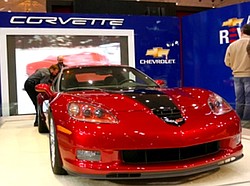Made in Lordstown, turbocharged car to please racetrack fans
GM expects a power boost
to increase Cobalt SS sales by as much as 40 percent.
By DON SHILLING
VINDICATOR BUSINESS EDITOR
The latest Chevro-let Cobalt is design-ed for a racetrack near you.
Slideshow from the Cleveland Auto Show

The turbocharged Cobalt SS is the quickest, most powerful Cobalt built yet at the General Motors’ Lordstown complex. It’s on display at the Cleveland Auto Show, which begins its nine-day run today.
The car won’t come out until April, but GM officials expect it do well with the “tuner” crowd — high-performance enthusiasts who like to modify their cars so they look good and go like crazy.
Ken Wasmer, engineering manager for GM’s high-performance cars, said the previous Cobalt SS, which had a supercharged engine, sold between 7,000 and 8,000 units a year. GM expects the turbocharged SS to sell 10,000 annually.
The turbocharger provides a more efficient and economical method of pumping compressed air into the engine, allowing the cylinders to provide more power.
Some SS buyers just like knowing they have the power, and some young professionals use it to tote around a child or two, Wasmer said.
But others like to use the power. Some of these people are auto cross racers, who set up a course with cones in a parking lot and run laps for time. The cars must be production models with factory tires and brakes.
“It’s a very low-cost way of racing,” Wasmer said.
Other enthusiasts take their cars to racetracks and pay about $200 to let their car go all out around the track.
The new Cobalt SS can go all out like no other version.
It packs 260 horsepower, compared with 205 for the model it replaces and 148 for the standard Cobalt.
It also can explode from the start. The new version goes from zero to 60 mph in 5.7 seconds, compared with 6.1 seconds for the supercharged model.
“We feel we really have a winner here,” Wasmer said.
Prices have not been announced.
The supercharged model actually was phased out after the 2007 model year because it no longer met federal emission standards. Rather than upgrade that system, GM switched to the turbocharger for the better performance, Wasmer said.
A turbocharger wasn’t used when the Cobalt was launched for the 2005 model year because GM didn’t feel it had enough experience with using it in a two-liter engine, he said. Since then, GM has been using a turbocharger in a Saab model with that engine, he said.
“We were ready to push the envelope a little further,” he said.
The new Cobalt SS also delivers 30 mpg on the highway with the 260 horsepower.
“That’s what I call mean and green,” Wasmer said.
The regular Cobalt with manual transmission gets 33 mph on the highway, while the automatic version is rated at 31 mpg.
Wasmer said GM was able to get close to those numbers with the Cobalt SS by adding a more aerodynamic front end and tires that provide good roll. Also, the turbocharger is more efficient than a supercharger because it is powered by exhaust fumes. The supercharger was attached to the engine by a pulley, which took away power.
The change in the Cobalt SS comes as the Lordstown complex is set to receive a new car model in June 2009 and another in 2010, although the exact models haven’t been announced.
Wasmer said an end date for the Cobalt hasn’t been announced, but it will go through the 2009 model year and indications are that it will be extended a year beyond that.
With that much time, GM officials thought an upgrade of the SS model made sense, he said. The turbocharger also is being added to other GM vehicles.
shilling@vindy.com
 43
43
